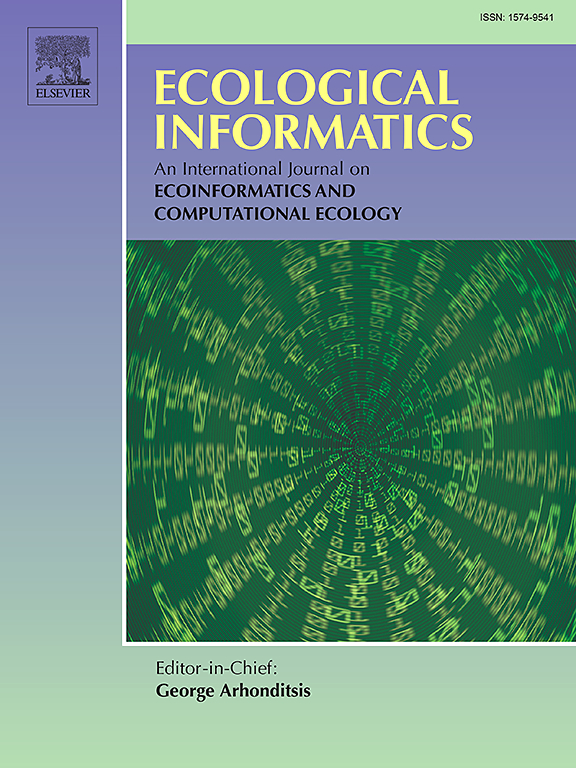珠海一号高光谱影像植被指数对快速扩散入侵种互花米草的监测
IF 7.3
2区 环境科学与生态学
Q1 ECOLOGY
引用次数: 0
摘要
互花米草是世界上危害最大的入侵杂草之一,监测互花米草的时空变化对有效管理沿海生态至关重要。然而,准确识别SA入侵仍然具有挑战性,特别是在周期性潮汐洪水的地区。近年来的研究表明,利用传统的多光谱植被指数(VIs),如NDVI和EVI,可以提高识别SA的准确性。然而,具有丰富衍生VIs的多时相高光谱图像的应用潜力尚未得到探索。珠海一号高光谱卫星提供了高光谱、空间和时间分辨率,为准确识别SA提供了关键的多时相特征。本研究使用高光谱图像和常见的机器学习方法(即k近邻、支持向量机、随机森林)对广西壮族自治区9个月的多时间VIs进行了研究,以比较各种VIs在识别SA入侵方面的性能。结果表明,与单个高光谱参数(光谱特征、VIs和空间纹理特征)相比,多时相VIs在周期性潮汐洪泛区识别SA更有效。值得注意的是,从高光谱图像红边波段获得的独特的多时相VIs的精度持续高于传统的NDVI(91.47%)和EVI(84.78%),其精度超过91.6%。我们的研究结果一致认为,6月、2月和11月是识别SA入侵的最关键月份,正如所有三种算法和VIs所观察到的那样。这些月份与SA物候的变绿、变黄和枯萎有关。本研究的结果和发现揭示了多时相高光谱图像分析在改善入侵物种监测和管理方面的巨大潜力,从而促进沿海生态系统的可持续发展。同样的程序、算法、指数和特征可以用来有效地识别任何其他特定物种或详细的土地覆盖类型。本文章由计算机程序翻译,如有差异,请以英文原文为准。
Evaluating multitemporal vegetation indices from Zhuhai-1 hyperspectral images for detecting a rapidly spreading invasive species - Spartina alterniflora
Monitoring the spatiotemporal changes of Spartina alterniflora (SA) is essential in effectively managing coastal ecology since it is one of the most harmful invasive weeds worldwide. However, it remains challenging to accurately identify SA invasion, especially in regions subject to periodic tidal flooding. Recent studies have shown that utilizing traditional multitemporal vegetation indices (VIs), such as NDVI and EVI derived from multispectral image features, can improve the accuracy of identifying SA. Still, the application potential of multitemporal hyperspectral images with rich derived VIs has not yet been explored. The Zhuhai-1 hyperspectral satellite offers high spectral, spatial, and temporal resolution, providing crucial multitemporal features for accurately identifying SA. This study examined multitemporal VIs from nine months using hyperspectral images and common machine learning methods (i.e., K-nearest neighbor, support vector machine, random forest) to compare a variety of VIs' performance in identifying SA invasion in the Guangxi Zhuang Autonomous Region. Results showed that multitemporal VIs are more effective in identifying SA in periodic tidal flooding areas than individual hyperspectral parameters (spectral features, VIs, and spatial texture features). Significantly, the unique multitemporal VIs derived from red-edge bands of hyperspectral images constantly demonstrated higher accuracies (exceeding 91.6 %) than traditional NDVI (91.47 %) and EVI (84.78 %). Our results consistently identified June, February, and November as the most critical months for identifying SA invasion, as observed across all three algorithms and VIs. These months are connected to SA phenology's greening, yellowing, and withering. Results and findings from this study provided insight into the overwhelming potential of multitemporal hyperspectral image analyses to improve the monitoring and management of invasive species for sustainable coastal ecosystems. The same procedure, algorithms, indices, and features can be employed to effectively identify any other specific species or detailed land cover types.
求助全文
通过发布文献求助,成功后即可免费获取论文全文。
去求助
来源期刊

Ecological Informatics
环境科学-生态学
CiteScore
8.30
自引率
11.80%
发文量
346
审稿时长
46 days
期刊介绍:
The journal Ecological Informatics is devoted to the publication of high quality, peer-reviewed articles on all aspects of computational ecology, data science and biogeography. The scope of the journal takes into account the data-intensive nature of ecology, the growing capacity of information technology to access, harness and leverage complex data as well as the critical need for informing sustainable management in view of global environmental and climate change.
The nature of the journal is interdisciplinary at the crossover between ecology and informatics. It focuses on novel concepts and techniques for image- and genome-based monitoring and interpretation, sensor- and multimedia-based data acquisition, internet-based data archiving and sharing, data assimilation, modelling and prediction of ecological data.
 求助内容:
求助内容: 应助结果提醒方式:
应助结果提醒方式:


